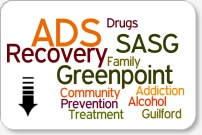

- Home
- The History of Alcohol and Drug Services
Historical Perspective
A journey in time through the history of ADS
Please help support Alcohol & Drug Services in your local community
Greensboro Drug Action Council

Greensboro Drug Action Council (DAC) was founded in 1971 to address the emerging variety of drug problems that were affecting the Greensboro community. Often referred to as "DAC", Greensboro Drug Action Council was one of the first steps in a long journey that would eventually lead to today's ADS (Alcohol & Drug Services). Along the way, Greensboro Drug Action Council added the Switchboard Crisis Center and TASC to its range of services. During the 1970's, several other entities also emerged to address alcoholism including Alcoholism Services of Guilford, the Alcohol Education Center, and the High Point Council on Alcohol Abuse and Alcoholism. Some of these would be merged into SASG (Substance Abuse Services of Guilford) years later. |
High Point Drug Action Council
|
High Point Drug Action Council added LINKS Adolescent Services prior to its merger with Greensboro Drug Action Council. |
Opioid Detox & Treatment
|
DAC began to utilize methadone to help local individuals deal effectively with their powerful opioid addiction. In the early 1980's, Greensboro's Sycamore Center was formed and would oversee the local opioid treatment program that would eventually become a core component of ADS (Alcohol and Drug Services) in 1994. Prior to ADS, Sycamore Center was absorbed into Greensboro Drug Action Council in the late 1980's. |
Crawford Treatment Center
|
Crawford Center would eventually come under the management umbrella of SASG (Substance Abuse Services Guilford). Crawford Treatment Center was closed in the mid-1990's when the newly constructed Guilford County Residential Treatment Facility was launched on West Wendover Avenue. |
Walker Treatment Center - Randolph County

Walker Treatment Center is located in Asheboro, NC. While obviously not a Guilford county locale, it is mentioned here because it is the current home of ADS in Asheboro and our center for SA services in the Randolph County area. Walker Treatment Center was an active detox and residential treatment program in the 1980's and 1990's. Those services were discontinued around year 2000, and ADS was shortly thereafter granted a contract by Randolph County to provide comprehensive outpatient substance abuse services out of that location. |
Construction of the WEST Treatment Facility
 High Point Drug Action Council (through a collection of community donations) constructed a new outpatient drug treatment facility in 1988 on Chestnut Drive in High Point, NC. That facility has often been called WEST over the years due to its physical location in Guilford county. High Point Drug Action Council (through a collection of community donations) constructed a new outpatient drug treatment facility in 1988 on Chestnut Drive in High Point, NC. That facility has often been called WEST over the years due to its physical location in Guilford county.
High Point Drug Action Council (and the WEST facility) would eventually undergo several mergers before ultimately becoming part of ADS (Alcohol & Drug Services). The WEST facility is now used as the administrative headquarters for ADS as well as offices for the Prevention & Early Intervention component of ADS. |
Greenpoint Chemical Dependency Centers of Guilford
|
The organization name, Greenpoint, was actually chosen from a contest to name the merged agencies. The winning name was the resulting combination of "Green" and "Point" taken from Greensboro and High Point. |
SASG (Substance Abuse Services Guilford)
|
|
ADS (Alcohol & Drug Services) Is Formed

In late 1994, SASG and Greenpoint merged to form what is known today as ADS (Alcohol and Drug Services). Since that time, ADS has had three acting CEO's: Ms. Diane Franco, Mr. Chuck Fortune, and the current President & CEO, Mr. Ron Rau, Jr. Mr. Rau was selected as the new CEO in 2006 by the ADS Board of Directors. Since 1994, ADS has weathered dramatic changes in the structure and delivery of substance abuse services across the state of North Carolina. The organization has adapted to the times and accepted many challenges along the way to maintain a high standard of quality care for the people that it serves. |
ADS Implements Computerized Records System

ADS implements a computerized records system that gives staff access to important client information from any ADS location. This new system integrated clinical records with event tracking and billing processes, and represented a significant step forward for the agency in its modernization efforts and record keeping. |
ADS Achieves CARF Accreditation

ADS applies for CARF accreditation and achieves this milestone. ADS has successfully maintained its CARF accreditation since its first award in 1997. |
ADS Launches Its First Internet Website
 With the growing popularity of the internet as an information resource, ADS publishes its first website to inform the public of its mission, services, and various programs. With the growing popularity of the internet as an information resource, ADS publishes its first website to inform the public of its mission, services, and various programs. |
2013
Revolution, Restructuring & Adaptation
|
The ripple effects have been nothing short of amazing as well as extremely challenging for the providers of treatment services and their local customers. During this period of high pressure & constant change, ADS diligently endeavored to serve those suffering with addiction. ADS continued to work hard to establish and maintain positive working relationships with many other human service organizations in the region and across North Carolina. During this period of frequent & pervasive funding cuts and dramatic statewide restructuring, ADS continued to fulfill its mission of serving those in the community who were struggling with the terrible disease of alcohol and drug addiction. It has not been easy as many can attest. A large number of human service organizations in Guilford County, once viable and important, are sadly no longer in existence. With funding cuts, excessive workloads, and modern high technology demands, many agencies closed their doors. With this loss of services, Guilford County residents felt the impact and still do today. Through these turbulent years, ADS sustained a constructive working relationship with many helping agencies past and present. While the future is never certain, ADS remains poised to do great things and has remained resilient through the collective efforts of its many dedicated staff, professionals, partners, and community patrons. The important services which ADS provides today include outpatient and intensive outpatient substance abuse programs, specialized judicial services, opioid treatment, and an extensive prevention and intervention department. |
ADS Launches New & Improved Internet Website

ADS develops & launches a modern website which provides improved functionality and future expansion capability. Internet technology was progressing rapidly and it had become increasingly important that human service agencies keep up with the wide variety of Federal and State organizations that oversee and fund substance abuse & mental health services. ADS also recognized the immense opportunity to better utilize the internet as a means of reaching its consumers and interacting with the many ADS stakeholders and supporters throughout North Carolina. |
ADS Adopts New Electronic Health Record (PIMSY)

After a thorough examination of electronic health records for behavioral healthcare, ADS adopts PIMSY (Provider Information Management System). PIMSY is the most complete and cost effective EHR on the market. PIMSY integrates many functions necessary for ADS' daily operations while offering expansion capabilities that will allow ADS' medical record to integrate with other Health Information Exchanges and which will provide clients access to parts of their ADS healthcare record online. |

